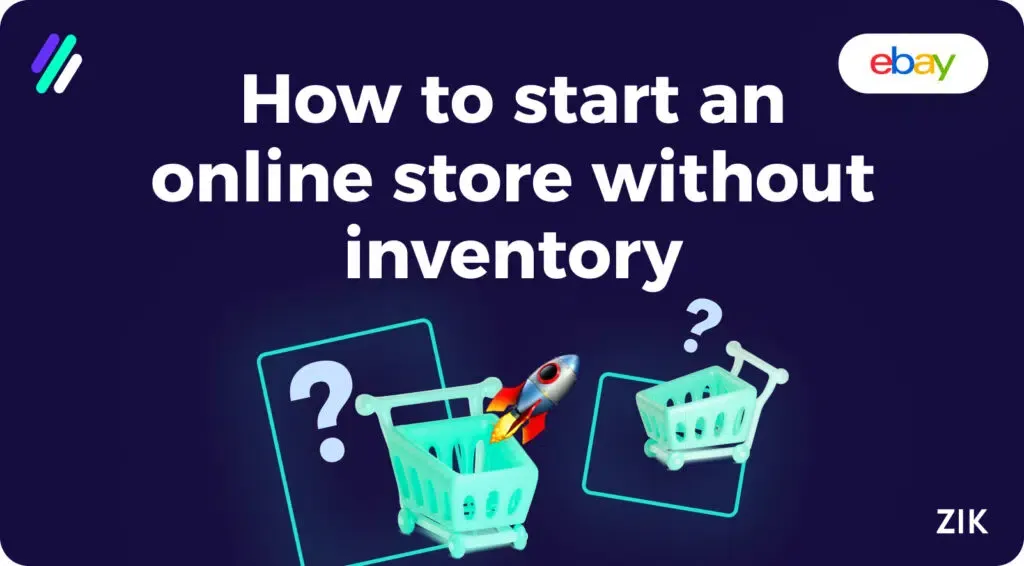Imagine starting your business in 2024 without spending a dollar or managing an inventory. Capital investment is a hurdle for many who want to sell products online because you need a substantial amount to buy your inventory and sell online.
But what if you can start an online store without inventory? Sounds too good to be true? Think again.
The digital ecommerce industry has opened up possibilities for aspiring online store owners, even those without or have a limited budget.
At ZIK Analytics, we have spent years researching products and various online business models. We specialize in data analytics on eBay and the ecommerce industry, allowing us to gain unparalleled industry insights.
Therefore, I will share with you in this comprehensive guide the strategies and tips you need to start an online store without inventory.
If you are looking for a sign to start selling online but are hesitant because you have no capital, take this as a sign! Keep reading to learn the proven formula to succeed in selling products online without inventory management.
Key Takeaways
- Dropshipping is a formidable business model for selling online without inventory.
- Carefully vet the various e-commerce platforms and digital marketplaces, which can be critical to your online business success.
- Invest in a product research tool, like ZIK Analytics, to obtain industry insights and relevant sales data when choosing the best products for your store.
Why Choose Dropshipping eCommerce Business Model?
The dropshipping business model is ideal to sell online without inventory. That said, it makes the perfect choice for anyone wanting to make money from the eBay ecommerce platform without initial investment.
Yes, you can start a dropshipping business with zero dollars. Yes, you heard that right. Zero investment.
Check out this recent video we released on our YouTube Channel detailing exactly this!
If you’re on a tight budget or don’t have enough capital to build your own online store with an online store builder, dropshipping is the way to go! With the right products, you can make a steady stream of sustainable income with this business model.
Of course, investing is possible if you have those set aside to launch your online store. But if not, it is accessible to anyone, and you can reinvest any profits you generate from selling online to grow and scale your online business.
But here is what you need to know before starting the dropshipping business model: use it as a launchpad, not your final destination.
It is an opportunity to test the waters before exploring other ecommerce businesses or business models. It is a risk-free approach to start selling online and learn the ropes.
In this guide, I will show you the steps to succeed with an online store without inventory focusing on dropshipping on the eBay platform – which is where ZIK got our start! Also, you will discover what tools can empower your ecommerce businesses to grow and become your main income source.
Exploring Inventory-Free Models: Dropshipping vs. Print-On-Demand
The dropshipping business model is excellent for selling online without holding any stock, as it allows you to fulfill orders directly from a supplier. However, if you’re looking for other inventory-free options, Print-On-Demand (POD) might also suit your needs. Both dropshipping and POD share a similar process: no upfront inventory and low start-up costs. But they differ in terms of customization and product type.
Dropshipping: This model works well if you aim to sell various ready-made products, like electronics or home decor. By using dropshipping, you can select a broad range of items already popular in the market and sell them under your store’s name. With dropshipping, you also have the flexibility to test new niches quickly without committing to inventory.
Print-On-Demand (POD): POD is ideal for customized products, such as T-shirts, mugs, or phone cases, and allows you to add unique designs for each order. It offers a unique appeal as you can add personalized branding, setting your store apart with original designs. This model requires a partnership with POD services that handle the printing, fulfillment, and shipping processes.
Step-by-Step Guide to Print-On-Demand (POD)
If you’re interested in selling custom products, here’s how you can start a print-on-demand store:
Step 1: Choose a POD Platform
Some popular POD platforms include Printful, Printify, and Teespring. Consider each platform’s range of products, ease of use, and integration with Shopify or other ecommerce websites. Look for a platform that allows seamless integration with your chosen ecommerce site and reliable production quality.
Step 2: Set Up Your Store and Design Your Products
Choose a store name and brand style that reflects your niche, then upload designs for your chosen products. Many POD platforms offer design tools to help you create professional-quality products directly on their site. Consider offering a small range of designs to start and focus on quality.
Step 3: List Products and Set Prices
Add product listings to your ecommerce store, and price them to cover costs and generate a profit. Ensure your products have high-quality images and engaging descriptions that appeal to your target audience.
Step 4: Market Your Store
To reach your audience, focus on using social media platforms like Instagram and Pinterest, as visual platforms tend to perform well for custom products. You can also consider Facebook and Google ads to increase visibility and attract potential customers.
Step-by-Step Guide to Starting a Dropshipping Store
Starting a dropshipping store requires careful planning and the right tools. Here’s how to get started:
Step 1: Choose a Dropshipping Platform
Select a dropshipping platform, such as eBay, Shopify, or Amazon, depending on your goals and budget. Each platform offers unique advantages, like eBay’s vast user base or Shopify’s customization options.
Step 2: Find Reliable Suppliers
Research suppliers that align with your store’s niche and provide quality products. Look for suppliers on AliExpress, Oberlo, or Spocket, and assess product reviews and shipping times. A strong supplier relationship ensures reliable order fulfillment.
Step 3: Set Up Your Store and Integrate with a Product Research Tool
Use a tool like ZIK Analytics to find trending products and understand your competition. Integrate this data with your store setup to choose products that will perform well. This step helps you make data-driven decisions to maximize your sales potential.
Step 4: Market Your Store
Build a marketing strategy that includes search engine optimization (SEO) for organic traffic and paid ads for visibility. Try running a Google Ads campaign for a high-demand product to get immediate traffic and use ZIK Analytics to refine your product selection based on performance insights.
A Detailed Guide to Start an Online Store without Inventory in 2024
Follow the steps I will outline here on how to start an online store without inventory. Let’s go over the steps!
Step 1: Choose the Dropshipping Platform
Once you start your dropshipping journey, the most crucial decision you will make is choosing the dropshipping platform. Many factors play into your decision, such as ease of use, integration capabilities, and market reach.
If you are new to selling online, having a user-friendly interface and prompt issue resolution will be vital factors in choosing a digital marketplace.
Dropshipping with Amazon allows you to leverage its vast customer base. You can also streamline your ecommerce businesses using Amazon’s fulfillment services, giving added credibility and ease in managing your online store.
Shopify is another popular ecommerce platform for the dropshipping business model. A Shopify store is a great option for online business owners who want to customize their online stores and have more control over branding.
However, it’s not ideal for starters because you need extensive marketing skills and budget to increase visibility for your dropshipping store.
eBay is the most popular option for dropshipping and online businesses without managing physical inventory. It is the platform that I personally recommend because I’ve had the most success on this platform, especially with the use of a market research tool like ZIK Analytics.
While it is highly competitive with many other eBay dropshippers, you can tap into its massive active user database. The various product listings offer flexibility in how you sell online, whether you want to actively or passively manage your online store.
Weigh the pros and cons I mentioned here to help you pick the right dropshipping platform. Your choice can make or break your ecommerce business success.
Step 2: Set Up Your Dropshipping Account
If you choose eBay as your dropshipping platform, you must create an eBay account to sell products online. Creating an eBay account takes only a few steps.
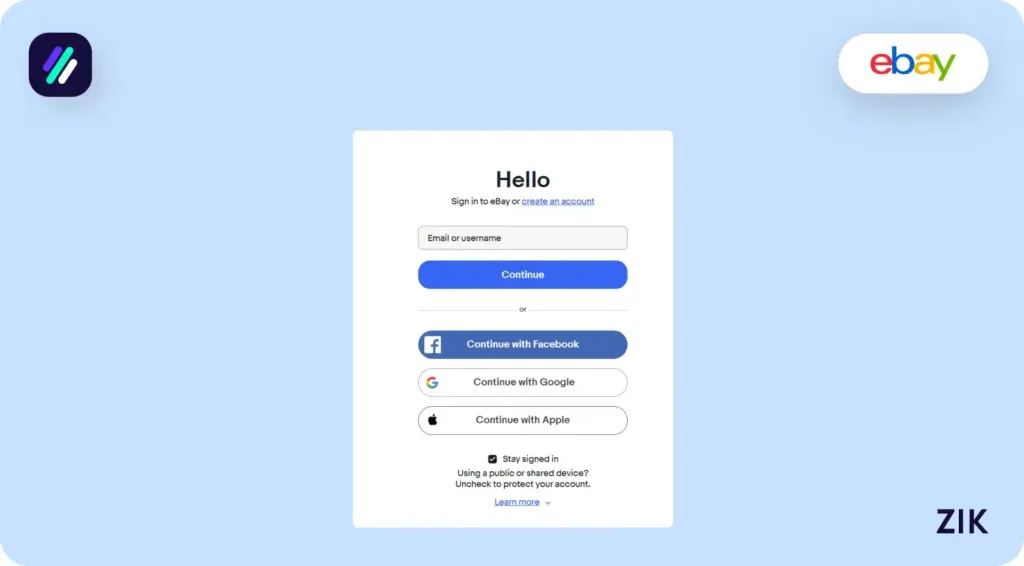
Go to the eBay homepage and sign up for a free account. Choose a store name and make it memorable but relevant to your niche.
You must also provide a business description, which gives an overview of what products you will sell online and highlights a point of differentiation from other eBay sellers and dropshippers.
And don’t forget to add a profile image! It adds to your store’s credibility, making it easier to earn customer trust.
You can check out our comprehensive guide to setting up an eBay store here.
Step 3: Choose Your Dropshipping Products
This is where the fun part of selling online without your own inventory is, but it is also the most challenging. Choosing what products to sell online is critical for ecommerce businesses because you want to target high demand products that your potential buyers will want to buy!
I use various market research tools to obtain industry data and insights that help identify the winning products for my ecommerce business. Therefore, I strongly suggest you find a tool to arm your decisions.
But before I get ahead, let’s identify what constitutes a winning product. How do you know if a product is good to sell in your ecommerce store?
The most important quality of a winning product is high demand. This product must have at least two sales in the last seven days. It means that when a customer purchases a product, there is a demand for it.
Selling products with substantial demand also benefits your online store because it guarantees you can generate a passive income.
However, consider seasonal trends that could affect sales performance and evaluation of products when selling online. Always check a product’s sales history when validating the potential of products in any ecommerce platform.
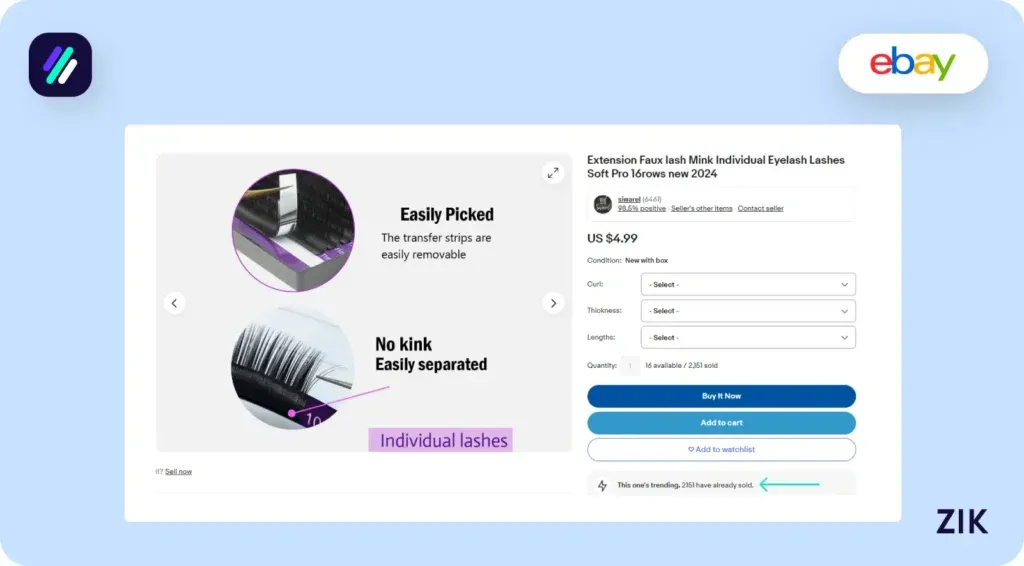
The next factor in finding winning products to sell online is pricing. Aim for products with competitive pricing. Choosing the cheapest products for your ecommerce business is not always the wisest move.
However, you must refrain from selling products that are overpriced either.
When you start an online store, the best products would be those that balance demand and competitive pricing.
With these factors, you can make passive income without inventory or your own products.
If you are looking for a list of items to add to your store this year, we have updated our “what to sell on eBay” guide to be relevant to 2024
Step 4: Market and Product Research
Success with ecommerce businesses without inventory management is possible. However, you must conduct market research to obtain essential data and sales history to help you decide which products to sell online.
As I mentioned earlier, choosing your dropshipping products is critical to a successful online store. With ZIK Analytics, the data and analytics you need to find trending products or niches and analyze your competition are within easy access.
This market research tool proves invaluable if you want to stay ahead of the competition and excel in the dropshipping game.
To use ZIK Analytics, you must update the seller settings to match your ecommerce platforms and your market (such as eBay US or UK). This step is crucial when researching the top selling products online because you want the data to reflect the intended market or audience base.
For example, if you are dropshipping in the US, use the eBay US setting on ZIK Analytics. It will provide you with relevant sales data and information about the eBay US market, giving you valuable industry insights with just a few clicks.
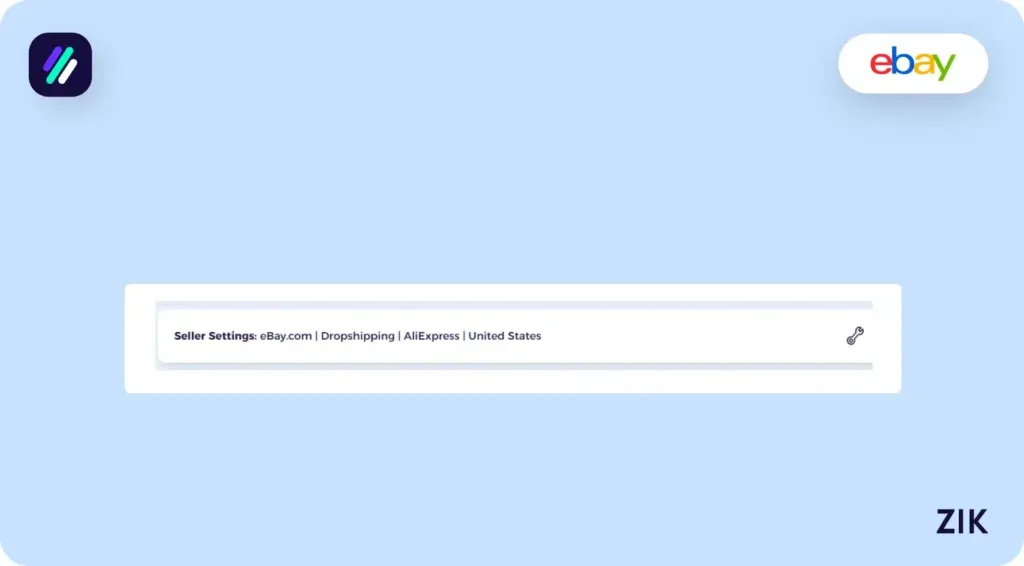
And since there are many ecommerce platforms, such as Amazon and Shopify, you must update the settings for eBay (if you are dropshipping on eBay) to reflect the data you want to see!
There are various strategies for using the data from ZIK Analytics for your ecommerce businesses to make more sales without inventory. First, you must look for “traffic products.”
The so-called traffic products are any top selling products priced at $15 and below. At this lower price point, these products are easier to sell online, enabling you to get your sales record to grow in a short period.
The more sales you generate over a short period, the more it will positively affect eBay’s algorithm. EBay’s algorithm prefers products that do well in sales, so the listing will appear on search results for a relevant query.
Once you get on the ZIK Analytics dashboard, you will find a list of trending eBay products that are already available. These trending products have high demand and high sales performance.
Before listing any of these items in your dropshipping ecommerce store, you can research that product further to obtain more insights about its sales history and other pertinent information.
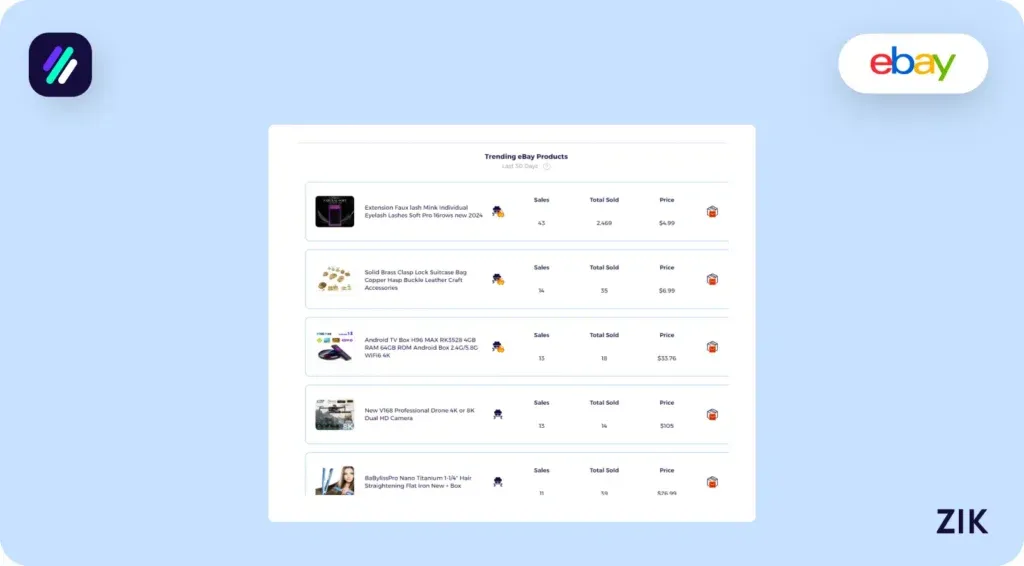
Another nifty feature I use on ZIK Analytics is sourcing potential suppliers. You can check out similar products on supplier websites like Aliexpress when you scan a product or niche.
You can check out how much those products are listed on Aliexpress and other supplier websites, which will give you an idea of your potential profit margin if you add these top-selling products to your store.
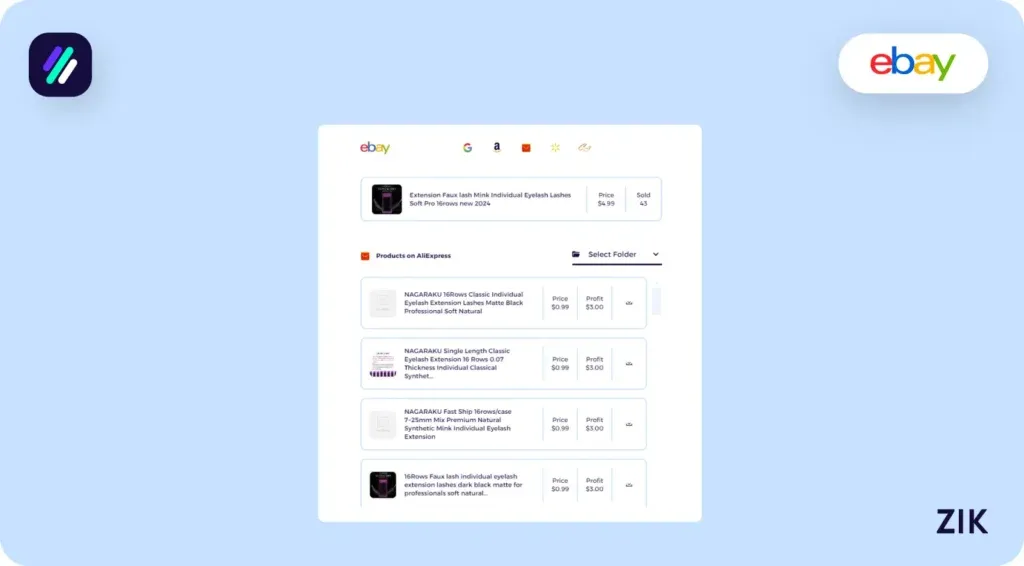
One thing to remember: Traffic products are an excellent addition to your e-commerce business, not because they can give you massive profits but because they sell fast and will boost your seller rating.
Long-Term Strategy
The marketing tips provided here are to help you launch your dropshipping business and start an online store without inventory. Once you start gaining sales in your store, consider reinvesting those profits to scale your business.
Once you have enough capital, you can focus on finding more profitable items. Let’s say you can aim for products that range in price from $20 to $50.
With these winning products, you don’t have to aim for more sales because you can rake in a higher profit margin per sale.
The ZIK Analytics market research tool would be an invaluable partner in growing your business, from not having your own inventory to building successful ecommerce businesses with huge profits!
Leverage the advanced product research tools to perform competitor analysis and tweak your own ecommerce strategy.
Final Thoughts
Starting and growing an ecommerce business without inventory requires adaptability, persistence, and a willingness to learn. Using these strategies, you can watch your ecommerce business grow and generate a passive income, even without initial investment or inventory management at the beginning!
Frequently Asked Questions on How to Start an Online Store Without any Inventory
Here are some frequently asked questions on selling online without any inventory:
How to open an online store without inventory?
You can start an online store without inventory using dropshipping, print-on-demand, affiliate sales, or digital products. Set up your site, connect with suppliers that fulfill orders for you, add your products or designs, and begin marketing your store.
How much money do you need to open an online store?
Starting an online store typically costs between $300 and $1,000 for essentials like a domain, hosting, and design. If you plan to invest in marketing, branding, or inventory, expect startup costs to range from $2,000 to $5,000 or more overall.
Is it possible to sell on Amazon without inventory?
Yes, you can sell on Amazon without holding inventory by using dropshipping, print-on-demand, or Fulfillment by Amazon (FBA). In these models, suppliers or Amazon handle storage and shipping, allowing you to focus on listing management, marketing, and customer service.
What is the easiest stuff to sell online?
The easiest items to sell online are small, lightweight, and in constant demand. Examples include phone accessories, T-shirts, candles, reusable bottles, and beauty products. These items ship cheaply, attract impulse buyers, and perform well across multiple platforms like Shopify, Etsy, and eBay.
How much does Amazon charge to sell?
Amazon charges a monthly subscription fee of $39.99 for Professional sellers or $0.99 per item for Individual sellers. Additional costs include referral fees of 8–15% per sale, closing fees for media items, and optional fulfillment fees if using FBA services.
What products sell best on Amazon?
Top-selling products on Amazon include electronics, home and kitchen gadgets, beauty items, fitness accessories, and pet supplies. Everyday essentials like phone chargers, water bottles, and cleaning tools also perform well due to consistent demand and competitive pricing in multiple categories.
How much is Shopify per month?
Shopify’s pricing plans vary: the Basic plan is $39/month, the Shopify plan is $105/month, and Advanced is $399/month. There’s also a “Starter” plan around $5/month for very simple setups. Additional costs include apps, themes, and transaction fees.
Do you need an LLC to open an online store?
No, you don’t need an LLC to open an online store. Many sellers start as sole proprietors. However, forming an LLC provides legal protection by separating personal and business assets, which is helpful as your business grows or handles higher transaction volumes.
Can I start an online store with no money?
Yes, you can start an online store with no money by using free platforms, print-on-demand, or dropshipping. These models require no upfront inventory costs. You’ll still need to invest time in marketing, product research, and building traffic to generate consistent sales.













